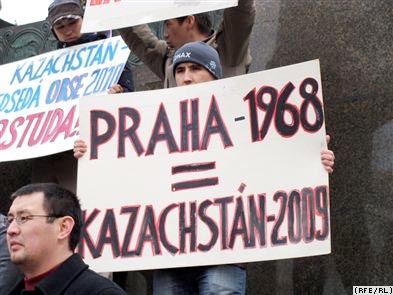Despite Constitutions, Intolerance Persists In Central Asia
By Merhat Sharipzhan | Мар 14, 2009

On March 5, the Tajik parliament adopted in the final reading a new law on religious organizations. The new law is much less liberal than one adopted in 1992. Although deputies who spoke in favor of its passage said it treats all faiths equally, it in fact gives priority to the Hanafi school of Islam, to which 90 percent of the population of Tajikistan adheres.
If signed by the president, the new law would ban the propagation of other religions, in contrast to the more liberal law it supercedes. The new law also imposes new regulations for religious schools, which in future must be attached to and supervised by so-called Friday mosques, or by Orthodox churches with a congregation numbering over 15,000. No religious schools would be allowed in small mosques or churches.
In January 2009, Kyrgyzstan adopted a new law on religion that officially bans missionary activities and proselytism.
In Uzbekistan, where missionary work and proselytism have been officially banned since 1998, five journalists from a Tashkent-based Islamic periodical were sentenced last month to prison terms ranging from eight to 12 years for propagating the teachings of Said Nursi.
Two months ago, a court in Kazakhstan sentenced a Russian citizen and missionary of the Unification Church, Elizaveta Drenicheva, to two years in jail for her religious lectures.
On January 27, a U.S. citizen, Bhati Bringha Gowinda Swami, was deported from Kazakhstan after landing at Almaty airport, even though he had a valid visa.
In Almaty, the municipal authorities ordered Kazakh followers of the Krishna Consciousness Society to vacate premises they owned in the city by February 28.
Last year, Hare Krishna followers in Kazakhstan were officially deprived of their place or worship and of private residences constructed on land they had purchased on the outskirts of Almaty in the late 1990s. Similar instances of harassment of religious minorities by local officials in Kazakhstan’s regions were reported once a month on average in 2008.
On February 7, a group of Kazakh Salafi Muslims staged a protest in Prague to ask for political asylum. They claim that they would face persecution if they returned to Kazakhstan.
Difference Between Paper, Practice
There are, to put it simply, no signs of any easing of restrictions on religious practices by non-Muslims in Tajikistan, Kyrgyzstan, Uzbekistan, or Kazakhstan, even though the constitutions of all four countries “guarantee the rights and freedoms” of their citizens, including freedom of belief and religion. While on paper the relevant laws treat all religious denominations equally, in practice governments do everything they can to impose stricter control over religious groups, including so-called traditional religions.
The former Soviet republics do not lack relevant experience.
During the Soviet era, leaders of religious communities were appointed by so-called Spiritual Boards and were widely believed to have been selected by, and to answer to, the Committee for State Security (KGB). Only official religious communities were allowed to function freely. After the collapse of the USSR, many former Soviet citizens either reverted to their traditional religion or embraced new faiths, including nonofficial branches of Islam and non-Orthodox Christian sects.
Tsarist Russia’s colonial policies included baptizing non-Russian minorities on the territories subsumed into the empire. Being baptized into the Orthodox Church for a non-Russian meant becoming a Russian. A newly baptized non-Russian was generally given a new Russian name and surname and was subsequently considered an ethnic Russian.
After the Bolsheviks came to power and imposed draconian restrictions on religious beliefs and practice, indigenous populations in Central Asia and the North Caucasus and Volga regions were still referred to as Muslims, but only in order to differentiate them from ethnic Russians — hence the survival into the 1920s of such controversial slogans as “Muslim Communists of Turkistan support …” even though being a communist precluded being a practicing Muslim.
Economic hardship in the early 1990s and the gradual worsening of the human rights situation in some parts of the region impelled some Central Asians to turn to Islam. Disadvantaged young rural Kazakhs, in particular, feel resentment at the privileges — study abroad, luxury cars — enjoyed by their urban contemporaries, and many of them have turned to extremist Islamic groups that promise equality and fairness by imposing Shari’a throughout the region.
One such example is the Islamic Movement of Uzbekistan, which initially sought to remove Uzbek President Islam Karimov from office but later began propagating the establishment of an Islamic Caliphate in Central Asia. Thousands of young Central Asians joined the movement in the belief that it was the only way to achieve justice and fairness.
Fearful lest any unofficial religious group become so popular as to pose a threat to political stability, Central Asian leaders seek to co-opt all Islamic and other religious groups in their respective countries. In officially registered government-controlled mosques, clerics in their sermons laud the leaders of the “Stans” for bringing stability and prosperity to their countries.
Merhat Sharipzhan is senior editor of Headline News at RFE/RL. The views expressed in this commentary are the author’s own and do not necessarily reflect those of RFE/RL.















